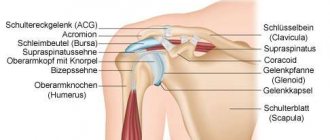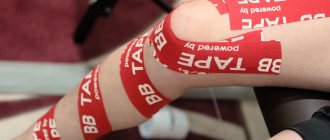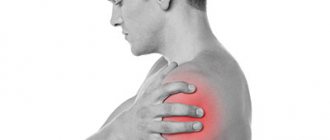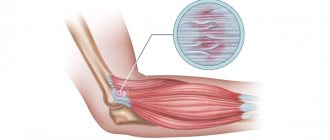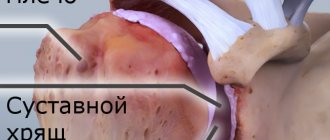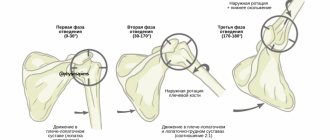Injuries to the shoulder joint for an athlete of any sport are accompanied by a long period of convalescence. This is due to the impossibility of complete immobilization of the joint due to the fact that the hands provide a person with a full life. In addition, a person writes, eats and even walks with the help of his hand. Of course, you can put a support bandage on your arm, which will fulfill its therapeutic role, but often athletes neglect this and simply use a variety of local medications that relieve the symptoms of injury and partially promote tissue regeneration.
Current shoulder kinesio taping
Nowadays, any athlete knows what kinesio taping is and how this method helps in rehabilitation after injury. For the shoulder joint, the kinesio taping method is a very effective treatment, because it has a large number of advantages.
Click to enlarge
The advantage of kinesio taping of the shoulder joint over other immobilization methods:
- Ease of use.
- Kinesio tape does not lose its properties when swimming. You can take a shower with it, swim in the pool and even steam in the sauna.
- High-quality tape will retain its properties for 5 days.
- The tape is not visible under clothing, so it can be worn at a time convenient for the person.
The physiological effect of taping on the condition of the damaged area:
- Improving blood circulation by raising the skin above the injured area.
- Strengthening lymph flow, which prevents the formation of swelling of the damaged muscle or ligament.
- The elasticity of kinesio tape provides soft immobilization, which limits the damaged area in movement, thereby speeding up the healing process.
- Due to immobilization and increased blood circulation, pain is reduced.
In total, the effect of the taping method is to shorten the period of convalescence and prevent the formation of chronic injury.
Compliance with the rules for applying tape ensures that all the objectives of the method are fulfilled and guarantees effectiveness in treatment.
Contraindications
Despite all the advantages of applying kinesio tapes over medical elastic bandages, drug treatment and massage, this method, safe for health, has contraindications:
- oncological diseases;
- benign tumors in the area where the patches are applied;
- skin prone to injury and weak blood vessels;
- venous and arterial thrombosis;
- heart and aortic diseases;
- pregnancy (if the application is applied to the stomach).
Consulting with a doctor will help you find out for sure whether the kinesio taping method is right for you.
Indications for kinesio taping of the shoulder joint
Like any treatment method, taping has its indications and contraindications.
Indications for taping the shoulder joint:
- Dislocation of the shoulder joint without a fixed displacement of the articular surfaces in relation to each other. In this case, the joint capsule is not damaged. Only the ligaments and muscles that support the position of the joint are injured.
- Minor violation of the integrity of the anatomical structures surrounding the shoulder joint.
- Bursitis or inflammation of the joint capsule of the shoulder joint. In this case, it is better to combine kinesiotaping with powerful anti-inflammatory therapy, since prolonged inflammation can lead to impaired motor function of the joint.
The use of taping for the treatment of acute injuries is permitted only after the pronounced swelling symptom has been relieved. This rule allows you to prevent the use of tape where its use would be useless.
In general, the taping method is used as two options:
- Prevention of exacerbation of chronic injury or trauma to healthy tissue due to excessive load on the area. This method is often used by athletes during the competitive period, when the body is at the limit of its capabilities and any physical or mental stress can affect the condition of the muscular-ligamentous system. The tape will redistribute the load between the skin, self and muscles (ligaments), which reduces the load on the area directly under the tape.
- Providing mild immobilization of the injured area during the period of convalescence after injury. The recovery period is characterized by the practical restoration of the cellular structure of the damaged area, but still by relative instability. The tape ensures gentle healing of the area with minimal inconvenience.
Method of taping the shoulder joint and surrounding muscles and tendons
In order for the tape on the shoulder to retain its functions for as long as possible, it is necessary to follow some rules:
- Before applying the tape, it is necessary to cleanse the skin of dirt and sweat.
- Remove hair.
- Using alcohol solutions, remove any remaining grease and dust from the skin on which the tape will be glued.
- Select the appropriate type of tape bandage.
- Decide on the location and method of applying the tape.
- Measure the desired length of tape and round the ends. If necessary, immediately cut the tape into rays.
- If necessary, you can draw on the skin where the tape will be applied.
The procedure for gluing the tape on the shoulder:
- Kinesio taping of the deltoid muscle. A type Y bandage is required. The “anchor” is glued without tension at the site of attachment of the muscle to the humerus. Next, one ray goes to the front beams, and the second to the back ones. It is important not to stretch the tape. The same method of applying tape can be used for a sprained or bruised deltoid muscle.
- Taping of the supraspinatus muscle of the shoulder. We begin to stick the tape at the point where the collarbone attaches to the humerus. Glue the first 2-3 cm without tension, then stretch the middle part by 25-30% and above the spine of the scapula perpendicular to the axis of the spine. Glue the last 2-3 cm without tension. For better adhesion of the tape and the skin, you can intensively rub the tape directly on the patient after gluing.
- The next step involves strengthening all the muscle and tendon structures of the joint. To do this, take a wide tape 30-40 cm long and stick it on top of the shoulder joint. It is better to stick the tape from the middle, without stretching the final centimeters of the tape.
The end result is a well-immobilized joint. Even with sprained ligaments or muscles, this position of the tapes will reduce pain, improve blood circulation and lymph outflow, which will significantly speed up the healing process.
Why are kinesio tapes from South Korea considered the best in 2021?
The Korean brand BBTape offers sports patches made of premium quality materials. The adhesive base is hypoallergenic and in most cases is well tolerated without causing irritation or other negative reactions. There are no drugs or harmful active ingredients in the composition. The products are certified and safe for use at any age, including children. The BBTape assortment allows you to choose a tape in the right size and color for any purpose - taping the biceps of the shoulder to prevent injuries, applying applications for sprains, muscle pain and other situations.
SUBSCRIBE TO OUR CHANNEL OF THE INTERNATIONAL TRAINING CENTER BBTAPE ON YOUTUBE AND LEARN ALL THE SECRETS OF TAPING FROM FIRST HANDS!
Recommended Articles
The whole truth about cross-tapes and basic recommendations for their safe use. In this article we will analyze the five main myths about cross-tapes and learn how to use them correctly in order to achieve maximum results and not harm your health.
How to choose a facial tape in 2021 Kinesio facial tapes are elastic bands that have been used for treatment, rehabilitation and rejuvenation of patients for more than 40 years. They are made of natural cotton/nylon/artificial silk with a hypoallergenic adhesive base.
Advantages of BBalance™ tapes on the global market BBalance™ kinesiological tapes can rightfully be called the best not only in our country, but also in the world. How the brand managed to achieve such success and not stop there, we will tell you in detail in the article.
Ankle taping One of the most common types of kinesio taping is ankle taping. If previously, when an ankle joint was injured, athletes had to use elastic bandages that were uncomfortable and did not bring much benefit, but with the advent of tapes the situation has changed dramatically. And now, when acute fatigue injuries occur and to prevent exacerbation, not only in sports, but also in everyday life, tape is applied to the ankle.
Facial taping with cross-tapes Functional and cosmetological cross-taping is one of the balancing taping techniques. This procedure aims to restore balance to the facial muscles and nerves. It is popular all over the world due to its gentle effect on delicate and sensitive facial skin.
Ankle Sprain Taping Ankle sprain injury is a common occurrence. In the sports field, specialists face this problem every day. This is also not uncommon in everyday life. The treatment and recovery process for patients involves various measures. One of them, which can be safely called the best alternative to the usual elastic bandages, is gluing special patches.
Taping for supraspinatus tendinitis
Often, shoulder pain is caused by supraspinatus tendonitis. This disease is accompanied by pain when moving the shoulder, and sometimes the base of the neck hurts. Inflammation is caused by hypothermia or mechanical injury (sprain or tear of ligaments and muscles).
Taping for tendinitis is no different from the usual gluing of kinesio tapes to a joint. The only thing that needs to be clarified is the absolute absence of tape tension, since there should be no pronounced immobilization here. To reinforce the taping technique for supraspinatus tendonitis, you need to watch the video.
How does tape work?
In appearance, tape is a stretchable tape on a cotton or viscose base, with a layer of glue, which must be fixed to the skin according to a certain pattern. When used correctly, kinesio patches adhere tightly to the surface of the skin, are completely breathable and dry quickly when wet. Therefore, you can walk with them for up to 5 days in a row, taking any water treatments (swimming, shower). During this time, the tape has several effects at once:
- It redistributes the load between the ligaments and skin of the shoulder joint, thereby reducing the impact on internal structures and tissues.
- Improves blood flow in the damaged area, due to which hematomas resolve faster, pain is reduced, and muscle tone is strengthened.
Rhomboid muscle taping technique
When examining people with pain in the shoulder joint, it turns out that the inflammatory process also occurs in the rhomboid muscle.
The rhomboid major and minor muscles are located medial to the supraspinatus and directly below the trapezius muscle, so they cannot be taped. Taping the rhomboid muscle can be replaced by gluing tape to the trapezius muscle.
Applying tape to the trapezius muscle of the upper shoulder girdle:
- We stick a single-strip tape from top to bottom from the shoulder blades to the head along the spine. In this case, the patient is in a sitting position, with the head tilted as far forward as possible.
- We glue another single-strip wide tape onto the lateral bundles of the trapezius muscle. To do this, tilt your head to the side and apply the tape from the hairline to the spine of the scapula (to the shoulder joint). A similar position of the tape should be on the opposite side of the muscle. If necessary, you can stick additional tape, which will be located at an angle of 30 degrees relative to the spine, and start at the level of the 7th cervical vertebra.
Such taping will ensure relative motor calm of the muscles of the upper limb, but given the constant need to do something with your hands, it is better for the patient to further limit his movements until complete recovery.
Features of kinesiotaping for arthrosis and arthritis of the shoulder joint
Kinesio taping of the shoulder joint for arthritis and arthrosis should limit muscle and tendon tension to ensure joint movement. Their overstrain causes pain and additional irritation of the nerve endings. In addition, cartilage tissue is gradually destroyed, which increases pain.
Distinctive points in taping the shoulder joint for arthrosis:
A similar technique must be followed when kinesiotaping injuries to the articular surfaces of the shoulder. This concerns damage to the glenoid cavity (glenoid lip) of the shoulder joint. In case of serious damage, surgical treatment is necessary.
But minor injuries can be perfectly treated using kinesio taping of the biceps and shoulder joint.
Features of taping of concomitant pathology of the shoulder girdle
Sometimes pain in the shoulder joint is not caused by damage to the shoulder itself. The cause may be damage to the attachment of the pectoral muscles in the shoulder girdle.
Click to enlarge
To correct this condition, it is necessary to apply tapes to the pectoral muscles.
Features of taping the axillary area for pain in the shoulder joint:
- The anchor of the tape is located on the sternum at the level of the 6th-7th rib. We stick the tape at an angle towards the shoulder. We stretch the middle third by 30-50%. And we glue the last couple of centimeters in the area of the spine of the scapula.
For taping, you can use any type of tape: I, Y, lymph tape.
Can I use the tape myself?
In the hands of an experienced specialist, kinesio tape becomes a full-fledged treatment tool, which can also be combined with other techniques - massage, electrical stimulation, osteopathy, acupuncture, and so on. Anyone can learn how to apply tape by choosing only the appropriate technique.
However, experts recommend using this tool on your own only in simple cases - when you experience shoulder pain, physical strain or fatigue. But if the condition worsens and in case of sprains or fractures, it is better to consult a specialist. He will help you choose the appropriate technique, teach you how to use it correctly, taking into account your personal characteristics, and recommend how to combine it with other treatment.
